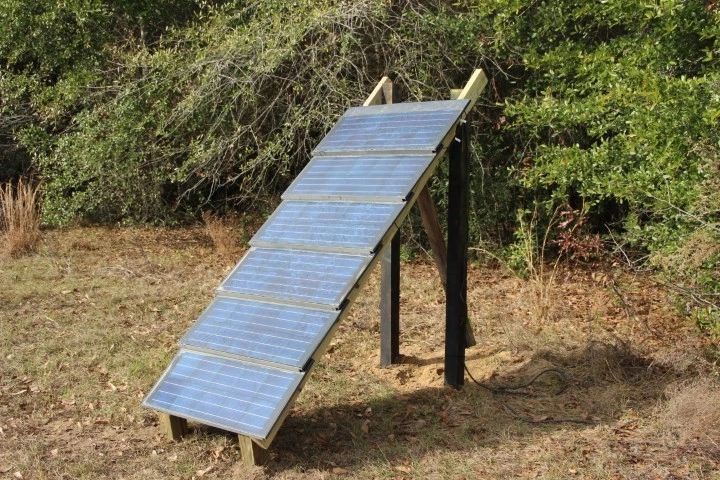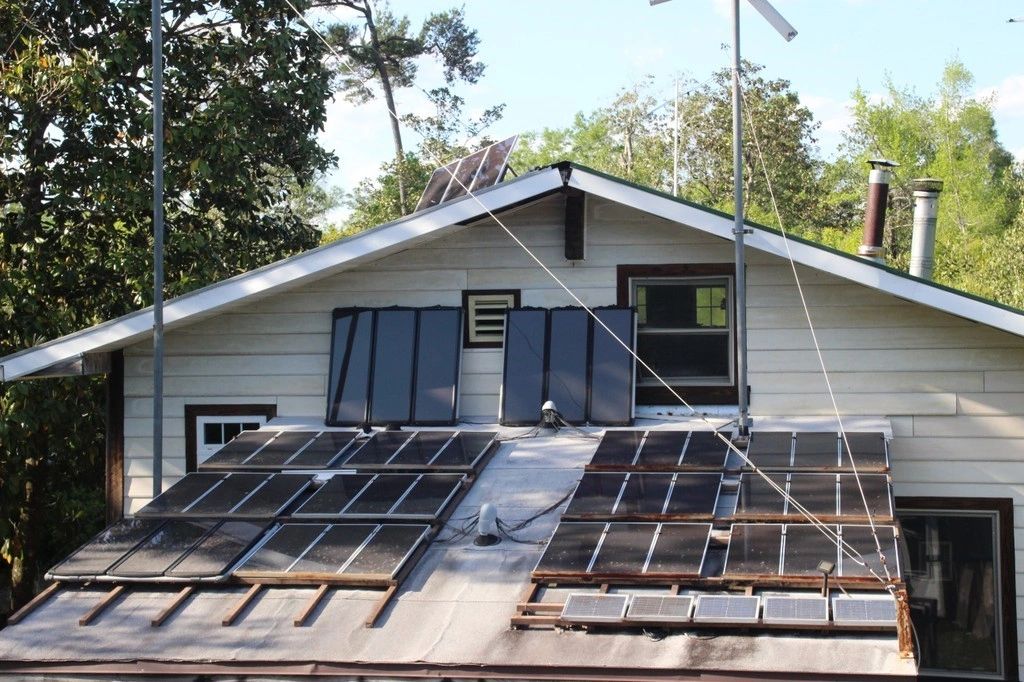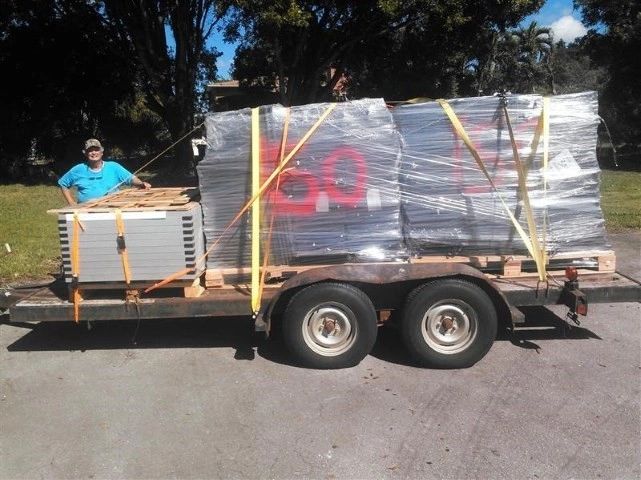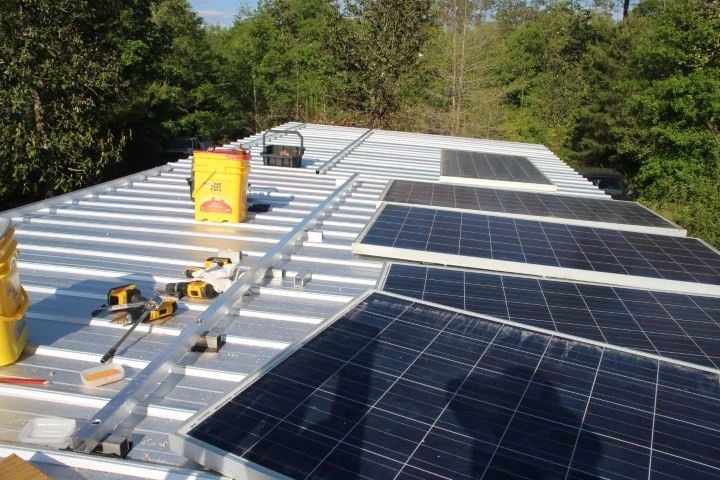The other day we talked about series and parallel connections of batteries. You know, getting 24 volts using four 6 volt batteries in SERIES and getting lots of amps at 24 volts by using 2 of those 24 volt strings (8 batteries total) in parallel. What about connecting your solar modules? Yes, it applies there, too. These roof tiles John is giving away, put out about 4 volts under load, so you use 3 of them in series to charge a 12v battery. I use 6 in series to run my 24 volt backup water pump. If you have a battery system and use an MPPT charge controller you might run 3 modules in series to get a good efficiency and stay under the 150 volt limit of the controller. If you are connecting a grid tie system with a string inverter, like a Sunny Boy, you may connect lots of full size panels for a voltage around 600 volts!Six 4v panels in series to run a 24v water pump located near my spring.

Connecting your solar panels in series is super easy and it saves money on wire, because several panels are connected using a single pair (positive and negative) of wires to the controller. Your modules probably have MC3, MC4 or Tyco connectors on them. Pick one connector on the first module and it will plug into the right one on the next module. The other one gets plugged to the next module. (If you use John’s free solar roof tiles, you might want to buy a sack of MC3 connectors because there will likely be some missing.) You can’t just do this forever because those panels are usually good for around 40 volts on the big”24 volt” panels and 18 or 20 on the “12 volt” panels. You could get some scary or damaging voltage added up in a hurry.Let’s say we have a 60 amp charge controller on a 24 volt battery. I don’t have particular specs handy but, generally, you’d say 60 amps X 24 volts = 1440 watts. Some controllers are real fussy about input wattage and even fudge a little bit on the specs. Some are rated higher and seem to just ignore a little extra power. Just remember 1440 for now.If you take three 300 watt panels and put them in series, you’ll have a max voltage of 120v, which is fine for this controller. Of course, 3 X 300 watts = 900 watts, so that being less than 1440 watts, you are safe to go. Sometimes, though, you have lots of cheap solar panels and want to get the most out of your BOS (Balance of System), so how many of these 300 watt panels can we use on the single 60 amp controller on this 24 volt system? Take your 1440 and divide by 300 and you get 4.8. You’ll have to round that down to a whole number, so that gives you 4 panels you can use.If you hook all of these panels in series, that’ll give you 160 volts on the input, so that is a no-no, as it exceeds the 150volt rating. TWO of those panels in series make 80 volts and that is ok. So if we take two in series and two MORE in series and connect the two sets in parallel, we can run 1200 watts (4 X 300) at 80 volts (2×40) into our charge controller and all will be good. If you have more panels you’ll have to have more charge controllers, or bigger ones, and calculate the optimal connection.TIME OUT! If you are getting scared or confused about 80 or 150 volts from your panels charging a 12, 24 or 48 volt battery…relax! MPPT controllers are magic! They detect the battery voltage and squeeze that higher voltage into your battery and get 20-30% more power out of the panels in the process. Don’t worry about how. Like I said, it’s magic, like using a 120 volt outlet to charge your 3.7 volt cell phone battery. Trust me.Now, there are exceptions to this general plan and that comes in the actual specifications of the controller you are using. A FlexMax 60 is rated at 1500 watts instead of 1440. This is from a real-world example at Stan-the-Hermit’s cabin. He has ten 300 watt PV modules and two 60 amp charge controllers. What he planned to do was put 5 panels in series on each charge controller. NO! Stan, don’t do it!!! The watts would be fine, but he’d have 200 volts going in, which would cause the smoke to come out. You never want to make the smoke come out of electronic stuff. (According to the Leo Ginn theory, electricity operates by the circulation of smoke molecules, so don’t let the smoke out.)The old 12 volt system was all wrong…and worked great.

What should Stan do, then? I don’t normally recommend sacrificing the low light capabilities of MPPT charge controllers by operating all of the modules in parallel, but that is what he will do on the new system because he’d rather spend the money on his girlfriends than charge controllers (which are less expensive). 5 panels in parallel on each charge controller should work fine. There are MC4 adapters that allow parallel connection of modules, saving wire and making parallel connection easy, but watch out for the current capacity of the wire you are using. A single 10 AWG pair will safely carry 30 amps, but will lose a little power in the wire. I buy a 1000′ roll of cable (wire gets cheap on the big rolls) and every string gets its own wire. This allows me to isolate a string with a bad panel, if one should fail in my system of all recycled salvage modules.Stan poses with his stack of 300 watt panels and my load of solar roof tiles in Miami.

Is there any other way of doing this series/parallel stuff to save money? Yes! A SINGLE 60 amp charge controller will handle all of his panels if he goes to a 48 volts system, because it still handles 60 amps. At twice the voltage you have twice the watts. On the old 12 volt system, he’d have to have twice as many charge controllers to run with all of those new modules! He’s going to stick with 24 volts, though, because he already bought the inverter.Stan’s solar shed. 2 old men, one rickety ladder and 600 lbs. of panels.

Here is something important to note and it has to do with MIXING panels sizes. Normally, you’d buy all the same modules and assemble your system, but there are those of us who are scroungers and have all kinds of stray inventory. When connecting in parallel, you need to connect modules of the same voltage output. Don’t mix 12 volt and 24 volt panels and don’t mix 60 and 72 cell panels. In series, if you have panels of different ratings, there is a chance of letting the smoke out, but it is a sure bet that you won’t get the full added output from the modules. You CAN use a hodgepodge of panels, but group similar panels on their own charge controllers. For example, if you have four 270 watt 60 cell panels on one charge controller and four 330 watt 72 cell panels on another charge controller, then everybody will get along fine and the smoke will stay where it belongs.By: Neal Collier
